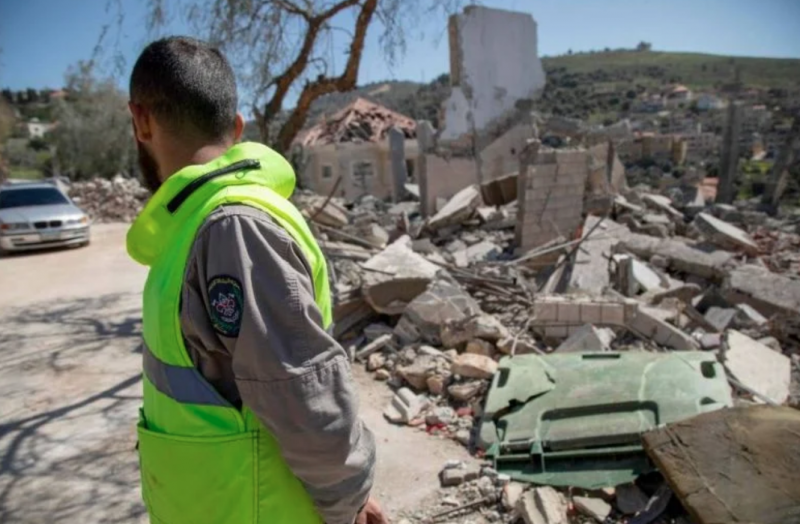
An Israeli raid devastated Adaisseh, a Lebanese border village in the south. March 5, 2024. (Credit: Hassan Fneich / AFP)
“The economic losses in south Lebanon are nothing compared to the huge Israeli losses,” said Hezbollah Secretary General Hassan Nasrallah during his March 14 discourse. According to Nasrallah, losses incurred by the war are minimal in South Lebanon but heavy on the Israeli side. However, Nasrallah did not provide figures to assess the damage on either side. Hezbollah’s research center said it has not carried out any studies on the subject.
To date, no official statistics are available to track economic losses related to the war, particularly since the conflict is ongoing. However, contrary to what Nasrallah said, the damage caused by Israeli shelling, particularly on agricultural fields set on fire on the Lebanese side is estimated to be quite heavy.
Nevertheless, experts and economists say precise figures on the extent of the damage on either side are hard to obtain. For the time being, they can only provide approximations drawn from data available on open sources. “We don’t have any studies at the moment. It’s still too early,” said economist Toufic Gaspard. On the Israeli side, the press has estimated that 70 percent of business owners in the northern towns and villages have left. Only the Israeli army is present in northern Israel.
Six million in losses every day
South Lebanon is also a region that journalists and experts can’t have access to without Hezbollah supervision. “They can only see what the party wants them to see,” said Khalil Helou, a military strategist.
To date, only a few preliminary studies carried out by survey firms have indicated the extent of the damage on the agricultural sector, which supports tens of thousands of families.
Information International estimated losses of at least $1,350,000,000 in terms of total or partial destruction and indirect losses affecting the Lebanese economy.
“In the first few days of the fighting, the economic activity fell by 20-25 percent," Mohammad Chamseddine, policy research specialist at Information International, told L’Orient-Le Jour. However, economic activity gradually returned to a more or less normal level, with a decline that was recently estimated at 10 percent, according to Information International.
“Lebanon has been losing an average of $6 million a day since the cross-border fighting began. As a result, total losses are estimated at more than $1 billion,” said Chamseddine.
This figure has even been revised upwards by caretaker Agriculture Minister, Abbas Hajj Hassan (who is close to the Amal movement, an ally of Hezbollah). In a recent interview with Egypt’s Al-Dustour newspaper, Hajj Hassan estimated the losses in the agricultural sector alone at “several million dollars.” He stressed, however, that this is an overall figure that is difficult to confirm so long as the war continues. The agriculture sector accounts for up to 80 percent of South Lebanon’s GDP, a UNDP report said in December 2023.
According to the National Council for Scientific Research (CNRS), the fighting has so far destroyed 10 million square meters of forest, olive groves and other plantations. According to Hajj Hassan, at least 50,000 olive trees were destroyed.
“Many people living in the south, particularly in Aitaroun, Blida and Mais al-Jabal, have not been able to profit from the olive harvest. Tobacco growers won’t be able to plant this year either, as they can’t access their land,” added Chamseddine.
Tobacco production in the southern border areas varies between 2 million and 2.5 million kilos. According to Statistics Lebanon, tobacco production in these villages accounts for 55 percent of the country’s overall production, generating $12 million in revenue for the region. “The destroyed buildings can be rebuilt, but the damage to the agricultural sector is almost irreversible. It will take years to repair the damage,” said a Western diplomat.
According to Statistics Lebanon, exports of fruit and citrus fruits alone dropped by 60 percent. This is particularly true given that, with a cultivated area of 7,500 hectares, the South alone generates 72 percent of the sector’s revenues ($16,250,000 out of a $22,500,000 in total).
Besides agriculture, some 7,000 (according to Chamseddine) to 9,000 (according to Rabih Haber, founder of Statistics Lebanon) residential units have also been totally or partially destroyed. There are also 21 factories and industrial and commercial firms that were damaged or destroyed, like the aluminum factory in Nabatieh and the industrial zone in Ghazieh, near Saida, which housed oil barrel warehouses.
To date, the bombardments have also destroyed at least six supermarkets, put several artesian wells and livestock farms out of action, and damaged a plethora of recently installed solar panels.
There are also indirect losses due to closing shops, companies and businesses in the south, which Statistics Lebanon estimated to be close to $300 million.
It is a hefty price for a country already ravaged by five years of economic crisis.
This article was originally published in French in L'Orient-Le Jour. Translation by Joelle El Khoury.